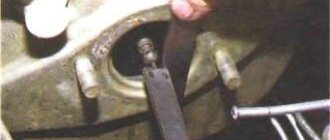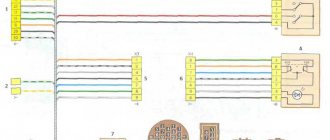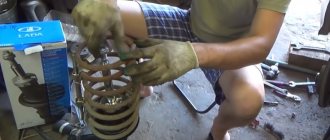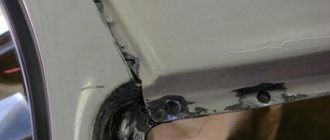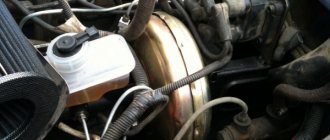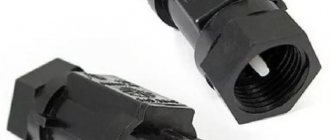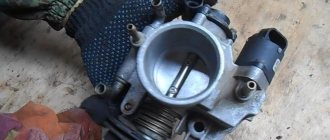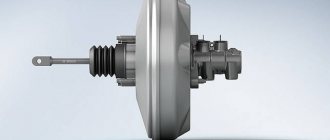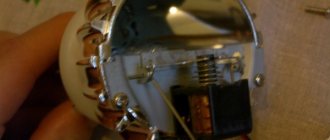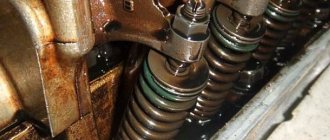The vacuum brake booster on a VAZ-2114 is faulty: what to do
Today, the automotive spare parts market is replete with VUTs for VAZs (it is worth mentioning that the information presented in the article is applicable for the VAZ 2115 and VAZ 2113) from a variety of manufacturers - from cheap Chinese models of dubious quality to very expensive models.
In general, VUT of more or less acceptable quality will cost you about 1 thousand rubles. We can confidently recommend for purchase “SPORT” vacuum cleaners from Polytech-Auto (Togliatti), the quality of which has been tested by numerous car enthusiasts. The warranty service life of such VUTs is one year, but in practice, they last much longer. According to reviews, replacing a VUT with a VAZ does not take about 3-4 years.
From this article you will learn how to change the vacuum on a VAZ 2114 with your own hands, without spending money on service stations.
REPAIR AND REPLACEMENT OF THE VACUUM BRAKE BOOSTER WITH YOUR OWN HANDS
It’s worth clarifying right away that replacing the VAZ 2114 vacuum booster itself is not anything overly complicated, and if you have the above tools and one and a half to two hours of free time, it can be done at home without any problems, so in order to repair the vacuum brake booster, it is not necessary to contact a service station.
Let's consider replacing the vacuum seal on the fourteenth with our own hands step by step:
- First of all, it is necessary to dismantle the rod that connects the vacuum seal and the brake pedal. This, as a rule, does not cause any inconvenience - just pry out the locking plate with a knife or screwdriver and unscrew the locking element;
- Next, open the hood and move to the engine compartment. We need to disconnect the TC (brake cylinder) and the vacuum seal. This is done with socket or ring wrenches, depending on what connections were used for fixation (usually ordinary nuts). There is one dubious issue here that you will have to decide: the fact is that you can do it in different ways - disconnect at the same time all pipes from the brake cylinder, which will make removing the VUT somewhat easier, since nothing will interfere with the process, but subsequently you will need to re-bleed the brakes. Or leave them in place and try to remove the VUT by unscrewing only the 10 mm nut that secures the tubes to the inner surface of the body.
- After the TC is moved to the side, we need to remove the hose that connects the VUT and the manifold;
- Next, we remove the vacuum seal from its attachment to the body wall; it is fastened with 13 mm nuts, so for dismantling we will need the appropriate wrench;
- We remove the amplifier along with the bracket on which it is attached. According to reviews, in rare cases, in order to remove the VUT, it may be necessary to unscrew the strut spacer;
- Now you only need to install a new VUT, using a similar algorithm in reverse order.
It is worth saying that the vacuum brake booster of the VAZ 2115 and VAZ 2113 changes in a similar way, so this instruction is applicable for these cars as well.
Replacement of VUT VAZ 2114
After diagnostics, you can proceed with replacement. You will need the following set of tools:
- Pliers.
- Keys for “10”, “13”, “17” (open-end, socket heads, sockets).
- Screwdrivers, flat and Phillips.
Pay attention to the condition of the fittings, clamps, and pipes. Replace them if necessary
All do-it-yourself repairs can be carried out at home without any particular difficulties; there is no need to turn to the services of a service station.
Repair stages:
- Remove the rod connecting the VUT and the brake pedal. It is necessary to pry the plate with a knife or flat screwdriver, and then unscrew the bolt.
- Having opened the hood, disconnect the GTZ (brake master cylinder) and the vacuum pump of the VAZ 2114. Usually simple nuts are used for the connection. Further dismantling is carried out either by disconnecting all pipes from the GTZ, or “live”. In the first case, of course, it will be much more convenient, but after repairs it is imperative to bleed the entire system.
- Remove the hose connecting the amplifier to the manifold.
- Using a socket on “13”, unscrew the nuts from the interior that secure the amplifier to the body.
- Remove the amplifier.
That's all, at this point the dismantling process can be considered complete, assembly is carried out in the reverse order. Usually this device is not repaired, but is immediately thrown away. Its price is not very high, and its service life is significant. Therefore, it turns out to be easier (and safer) to install a new VUT.
First you need to figure out what this vacuum amplifier actually is.
- This is a casing within which the valve is located. The element is structurally divided into two parts, which are separated by a layer of rubber - the diaphragm;
- One part of the amplifier is atmospheric, and the second is vacuum - it is connected to the inlet pipe from the power unit;
- The amplifier valve is a plastic casing containing the main elements that are subject to wear. It is because of them that the operation of the gearbox is disrupted. To be more precise, the gearbox begins to rattle;
- The composition of the valve is as follows: there is a rod on the bushing, adjacent to the buffer and piston. There is also the valve itself on the pusher and return springs with a filter.
Appearance of the device
Self-replacement of the vacuum booster on a VAZ 2114
First you need to figure out what this vacuum amplifier actually is.
- This is a casing within which the valve is located. The element is structurally divided into two parts, which are separated by a layer of rubber - the diaphragm;
- One part of the amplifier is atmospheric, and the second is vacuum - it is connected to the inlet pipe from the power unit;
- The amplifier valve is a plastic casing containing the main elements that are subject to wear. It is because of them that the operation of the gearbox is disrupted. To be more precise, the gearbox begins to rattle;
- The composition of the valve is as follows: there is a rod on the bushing, adjacent to the buffer and piston. There is also the valve itself on the pusher and return springs with a filter.
Appearance of the device
Main signs of VU failure
It is quite possible to check the vacuum booster yourself. However, to obtain more reliable data, it is recommended to use the services of specialists or use special diagnostic equipment. In this section we will look at how to determine the performance of the mass absorption mechanism in artisanal conditions. The main sign of a breakdown of this mechanism is the inability to form a vacuum in the working cavity. As a rule, the source of this problem can be damage (breakage, destruction, chafing, etc.) of the elastic pipeline connecting the VU with the motor manifold or depressurization of other segments of the system. The malfunction can also be caused by defects inside the amplifier.
Start the power unit and turn it off after a few minutes. Hold down the gas pedal, then release it and repeat the procedure. During subsequent presses, the pedal stroke should gradually decrease. If there is no difference, this indicates that additional force is not provided in the GTZ, therefore, repair of the amplifier is required.
Signs of a malfunction of the vacuum brake booster of the VAZ 2114
Brake booster malfunctions have several fatal negative consequences:
Significant reduction in vehicle control during braking cycles. In the absence of the amplifier, the load on the gas pedal increases proportionally - the pedal goes hard, and the braking effect is significantly reduced. For an unprepared driver, such behavior of the car can come as a shock and lead to a traffic accident due to the increased braking distance; If the brakes malfunction, a car loses significant braking potential and becomes practically uncontrollable;
The gas pedal is slow. When moving, the pedal is very difficult to press. This is a clear sign of a malfunction of the amplifier housing diaphragm chamber.
In this case, the car must be operated with great care, since it has lost a certain effectiveness of the braking system;
A sign indicating a faulty brake system lights up on the dashboard at short intervals. This symptom may also relate to other malfunctions in the brakes, but in combination with a tight brake pedal it clearly indicates a faulty booster
The electronic unit of the car constantly monitors all systems for operability (and although on the VAZ 2114 model this unit has not been considered modern for a long time with its functions, it copes with its functions at a good functional level and with high efficiency despite the small number of sensors);
Deterioration in the braking performance of the system, along with other signs, indicates a direct involvement of a faulty brake booster in the risk of an accident. This symptom is the main one among all the others; however, operating a car with a very weak brake system is very dangerous - the circuits in this case do not receive additional force and cannot effectively brake.
Troubleshooting most often involves replacing the faulty element with a new unit - this will save repair time, since resuscitation of an old product will require no less time and a slightly lower cost of parts. That is why car enthusiasts most often resort to complete replacement of a failed part.
Replacing the vacuum brake booster of a VAZ 2109 Replacing VUT on a VAZ 2108-2115 yourself Vacuum brake booster of a VAZ 21099 is the cause of air leaks. Part 2
Reasons for checking the performance of the vacuum brake booster
The car's braking system will not completely fail, even if the booster breaks down, but the driver will have to make much more effort to slow down the car. A clear sign of VUT failure is that the pedal becomes “hard” and braking efficiency drops sharply. This leads to a dangerous situation on the road.
In addition, other signs appear:
- free play increases to half;
- the operation of the power unit becomes unstable, this is especially noticeable at idle;
- the brakes “stick”, that is, the car continues to slow down even when the brake pedal has already been released.
Important. The VUT check must be carried out only when the car engine is running, since the amplifier can operate correctly only when vacuum is supplied from the engine.
Consider the reasons why the above damage to the vacuum booster may occur:
- the connection of the vacuum hose is loose, or air is leaking through damage in the hose;
- loss of tightness due to wear of the diaphragm;
- air valve failure;
- depressurization of the housing;
- decrease in spring elasticity.
You can seal the connection and replace the pipe yourself, just don’t forget to check the “vacuum seal” for functionality. However, if the check shows that the amplifier is broken, then the entire mechanism will probably have to be replaced.
We recommend
“Checking the hand brake: signs of malfunction and their elimination” Read more
Replacement of VUT VAZ 2114
After diagnostics, you can proceed with replacement. You will need the following set of tools:
- Pliers.
- Keys for “10”, “13”, “17” (open-end, socket heads, sockets).
- Screwdrivers, flat and Phillips.
Pay attention to the condition of the fittings, clamps, and pipes. Replace them if necessary
All do-it-yourself repairs can be carried out at home without any particular difficulties; there is no need to turn to the services of a service station.
Repair stages:
- Remove the rod connecting the VUT and the brake pedal. It is necessary to pry the plate with a knife or flat screwdriver, and then unscrew the bolt.
- Having opened the hood, disconnect the GTZ (brake master cylinder) and the vacuum pump of the VAZ 2114. Usually simple nuts are used for the connection. Further dismantling is carried out either by disconnecting all pipes from the GTZ, or “live”. In the first case, of course, it will be much more convenient, but after repairs it is imperative to bleed the entire system.
- Remove the hose connecting the amplifier to the manifold.
- Using a socket on “13”, unscrew the nuts from the interior that secure the amplifier to the body.
- Remove the amplifier.
That's all, at this point the dismantling process can be considered complete, assembly is carried out in the reverse order. Usually this device is not repaired, but is immediately thrown away. Its price is not very high, and its service life is significant. Therefore, it turns out to be easier (and safer) to install a new VUT.
Replacing the main brake cylinder and vacuum brake booster on VAZ 2114, 2115, 2113
The principle of operation of a vacuum brake booster
As we already wrote in the article about the master brake cylinder, the main problems that may arise when operating a car with a master brake cylinder are its depressurization and deterioration of braking.
We carry out diagnostics of the main brake cylinder
How to diagnose the main brake cylinder on VAZ 2114, 2115, 2113 cars, this is not very difficult to do, to do this you simply hold down the brake pedal with the engine off. And without releasing the pedal, start the car, if at this moment you feel that the brake pedal has failed, then the vacuum booster is working. If not, then you should check the tightness of the connection between the check valve, which is located on the amplifier body and the intake manifold fitting with the vacuum booster.
Another typical problem associated with the brake master cylinder is uneven engine operation. Problems with the master brake cylinder can even significantly affect the reduction in power of a VAZ 2114 car. To check this malfunction, simply firmly clamp the vacuum hose while the engine is running. If at this moment the engine of the VAZ 2114 car begins to work more stable, then the vacuum brake booster should be changed.
Tools needed to replace the brake master cylinder and vacuum booster:
- screwdriver
- pliers
- keys to “13”, ring and socket
- keys to “17”, ring and socket
— a special wrench for brake pipes at “10” (shown in Figure 1)
- new brake fluid to add to the system
— the plug fittings shown in Figure 2 will also come in handy; they will help save the brake fluid that is in your car system.
Now that you have prepared everything, you can begin to independently replace the vacuum brake booster and master brake cylinder of the VAZ 2114 car
Replacing the main brake cylinder on VAZ 2114, 2115, 2113
— first, disconnect the block with wires from the brake fluid level sensor as shown in Figure 3
— now, using a “10” wrench for the brake pipes, unscrew the brake pipes from the master brake cylinder. And as shown in Figure 4, install the plug fittings on the brake cylinder and brake pipes. This trick with these plugs will allow you to avoid airing the brake system, and will also save you brake fluid.
— Now, using a key set to “17”, unscrew the nuts that secure the brake cylinder to the vacuum booster (Figure 5). Remove the brake cylinder.
When installing, perform all steps in reverse order. It is worth knowing that when installing a new brake cylinder, it should be bled in a vice (filled with brake fluid).
Replacing the vacuum booster on VAZ 2114, 2115, 2113 cars
— First, you should familiarize yourself with what was described above about replacing the brake master cylinder. If you only need to replace the vacuum brake booster, then you don’t have to completely unscrew the master brake cylinder, but just disconnect the fittings that are on the left side and move the brake cylinder to the side so that it does not interfere with us when replacing the vacuum booster.
— using a “13” wrench (whichever is more convenient, socket or union), unscrew the 4 nuts for securing the vacuum that are attached to the car body, shown in Figure 8. They are very inconvenient to change, but I think you can handle it.
— Now we must screw the mounting frame onto the new vacuum (Figure 9) using a socket wrench at “17”
Assembly should be done in reverse order.
Helpful advice: when assembling, it is first better to connect the brake pedal and vacuum using a finger - a cracker, and only after that screw the vacuum frame to the body, this will be much more convenient.
It is also worth paying attention to the condition of the vacuum hose, usually during operation it loses its elasticity and flexibility, as a result of which cracks and loss of tightness may appear, since you have already unscrewed everything, it would not hurt to replace it immediately. We also recommend watching this training video
We also recommend watching this training video.
Repair of auxiliary pumps
As mentioned above, when a mechanical vacuum pump partially fails, some car enthusiasts simply remove their rod, thereby turning them off and eliminating the knocking noise that occurs when the pump operates. In this case, the brake booster will work, but not as effectively, which will result in a harder pedal. Some car enthusiasts get out of the situation by turning the rod 180 degrees. Sometimes this helps because it is only present on one part of them.
As for electric vacuum pumps, these units are usually irreparable; accordingly, they are simply replaced with new ones. Did not find an answer to your question?
The design of the brake system of any car must include a booster. The most widely used in transport is the vacuum type amplifier, which provides additional force due to vacuum.
Checking the brake booster valve
The vacuum brake booster may not work well due to a faulty check valve. To check its functionality, remove the hose, remove the valve from the brake booster housing and place a rubber bulb on it. It must be connected from the outside (from the side to which the hose is connected). Next, the pear should be squeezed and released. A compressed bulb indicates the serviceability of the check valve.
Otherwise you will have to replace it. You can also use this method to check the tightness of the inlet hose if you do not have a compressor at hand.
We recommend
“Why the parking brake is on: we’ll figure out the reasons” Read more
Removal of VUT
- To access the VUT fasteners, you need to dismantle the engine filter housing. To dismantle, unscrew the two bolts securing the housing at the front, also loosen the clamp securing the pipe and remove the connector from the mass air flow sensor. Turn the front bolts by hand and loosen the clamp with a Phillips screwdriver.
Release the clamp securing the adsorber and move it to the side without disconnecting the hoses. It is convenient to loosen the clamp with an open-end wrench by ten.
Unscrew the 2 nuts securing the brake cylinder and, together with the expansion tank, move it to the side. It is convenient to unscrew the nuts with a thirteen wrench.
Remove the pipe from the check valve fitting. Unscrew the four nuts securing the amplifier from the body. It is convenient to unscrew the nuts using a wrench with an extension and a cardan. Thirteen head nuts.
Remove the spring pin retainer that secures the brake booster rod to the pedal.
Remove the pin and disconnect the rod from the brake pedal. Remove the VUT by pulling it towards you from its seat.
Unscrew the two nuts of the bracket that secures the amplifier to the body.
Troubleshooting methods
What signs may indicate that the unit requires replacement?
- When applying the same force, the braking process becomes more difficult.
- When you apply pressure to the brake pedal, the speed begins to drop.
- The engine is adjusting.
- The appearance of hissing noises when the brake is pressed while driving. In this case, it is possible to increase engine speed.
- Inadequate operation of the brake pedal.
- Increased fuel consumption.
The results of a simple inspection will tell you whether the device needs to be replaced.
- Method No. 1. With the engine off, vigorously pump the brake pedal to the floor 4-5 times. Detection of creaking or hissing or other extraneous noise during these manipulations indicates that there are serious malfunctions. After this, holding the pedal in the lowest position, turn on the engine. A vacuum will begin to create in the VUT chamber. The pedal should move on its own. If this does not happen, then the breakdown is serious and repair is inevitable.
- Method No. 2. Let the car idle for 3-6 minutes. Silence it. Fully press the pedal (creating a vacuum in the chamber of the device) and release. Repeat again. If the stroke of the lever changes with each subsequent press, it means that creating a vacuum is difficult. Therefore, replacement of the problematic device is required.
- Method No. 3. Start the engine and squeeze the brake lever all the way. Turn off the engine and release the pedal. If it doesn’t move within half a minute, then everything is fine. The opposite result is a signal of a malfunction.
Sometimes deviations appear due to a broken fastening, flange failure, or mechanical damage to the vacuum hose. Therefore, in order not to complicate the situation, the inspection should begin by checking these positions.
Changing a unit yourself is not difficult if you have at least some mechanical skill and understanding of the design of the car. To replace it yourself, you will need the vacuum unit itself, some tools and parts.
Vacuum booster replacement process
In order to change the VUT, it is not necessary to unscrew the brake pipes leading to the brake fluid reservoir. Everything can be made much simpler.
- Step 1: Release the brake pedal; to do this, remove the small cotter pin at the top of the pedal;
- Step 2. Remove the barrel of brake fluid. First, disconnect the terminal located at the very top of the tank, and then unscrew the nuts that secure the tank to the vacuum booster;
- Step 3: You can start removing the vacuum seal itself. And this can be done in two ways: either unscrew the VUT itself from the bracket on which it is attached, or unscrew it together with the bracket, which is already secured to the body with 13 nuts. Here you can choose whichever is more convenient for you. The VUT is secured to the bracket with 17 nuts;
- Step 4: Disconnect the hose from the VUT, which comes from the intake manifold.
After dismantling, you can begin installing a new amplifier. If you unscrewed the old VUT together with the bracket, then move the bracket from the old to the new one and install everything in place in the reverse order.
https://www.youtube.com/watch?v=LmlbgzQtwNs
Replacing the vacuum brake booster of VAZ 2113, 2114, 2115
The content of the article:
Replacing the vacuum brake booster VAZ 2115
Along with replacing the brake discs, I also changed the vacuum brake booster; although the old one worked, it made hissing sounds when I pressed the brake pedal.
I bought a vacuum called the original, costing 1320, the choice was not the original, it was 150 rubles cheaper, you can’t save on this, and even 150 rubles. the weather will not improve.
We climb under the hood and begin to release the vacuum seal. For convenience, I removed the air filter housing and moved the absorber to the side. We unscrew the brake pipes suitable for the master cylinder and the two bolts securing the brake cylinder to the vacuum booster (arrows in the photo)
We remove the brake master cylinder and put it aside, you can throw it away if you have a new one.
Then, unscrew the 4 bolts securing the vacuum cleaner bracket to the body
two on one side, two on the other, a ratchet comes in handy here
We go to the salon, climb under the pedals, remove the corkscrew bracket securing the vacuum rod to the pedal, disconnect the rod
Now the vacuum seal is completely free
We take out the vacuum booster from under the hood. Now you can work on the ground. Unscrew the last two bolts securing the vacuum unit to the bracket.
We put the new and old vacuum next to each other, look at them, admire them, rejoice at the new spare part
Then we put everything back together in reverse order, don’t forget to bleed the brakes.
After replacing the vacuum and brakes, as I wrote earlier, I was not completely happy with the result. The reason for this was a faulty master cylinder.
GTZ VAZ 2115
After replacing the brake discs and vacuum brake booster, I was not happy with the braking: the pedal travel was long, it was caught at the very end, no information content, well, everything is wrong! Also, one fine day, on the way home, the brakes disappear completely. When I pressed the pedal all the way, the car barely stopped. Having opened the hood, I saw the following picture: the brake fluid level is at the minimum level, the entire GTZ is in the brake fluid, the fluid leaves from under the rubber seals, and when replacing, drips were found on the piston side. I was not very surprised by this, since initially the GTZ under the Fenox brand did not inspire confidence, there were traces of manufacturing on the outside, inside the channels were smaller in diameter than in the standard GTZ, and crookedly located, it’s a pity I didn’t photograph all this then, although it was in a sealed package, but There was no choice at that moment, and I got it for free, I had to install it.
Diagnostics of VUT
If the vacuum reservoir is faulty, the brake pedal becomes harder and braking becomes less effective. Also, VUT malfunctions can affect engine speed, especially in idle mode. When you touch the pedal, the speed may drop or rise.
It is worth noting that the vacuum reservoir is one of the most reliable parts in the brake system. The average resource is approximately 100-150 thousand kilometers.
Let us note the three simplest methods of self-diagnosis:
- We press the pedal 5-6 times and while pressing the pedal we start the power unit. When the VUT is working, the pedal should fall 2-3 cm and remain in this position. If it goes to the floor, the amplifier needs to be replaced.
- We start the engine and let it run for 1-2 minutes. We turn off the engine and press the pedal three times. If after the third press the pedal is soft, it means that the vacuum reservoir is not working properly and is sucking in air.
- With the engine running, press the pedal and hold it. We turn off the engine and do not take our foot off the pedal. Further, if the pedal does not move up within one minute, it means that the VUT is operational. If the pedal starts to press on your foot, it means it is sucking in air. Also, when the engine is running, you may hear a hiss of air when you press the pedal.
Principle of operation
Replacing the vacuum booster on VAZ 2114 and 2115 is required if it malfunctions. First, let's determine why such a breakdown occurs. Therefore, let's look at how this device works. The booster is located in front of the brake pedal. The amplifier rod is connected to the pedal. The vacuum itself has an oval shape and consists of two halves that are rolled to create a tight seal. A diaphragm is located inside the resulting part; it divides the cavity in half.
One part has access to atmospheric air, the other creates a vacuum by connecting to the engine exhaust manifold. When you press the pedal, an additional portion of air is supplied to the first chamber, which creates additional pressure on the diaphragm.
As a result, less effort is required from the driver to create the required pressure in the brake master cylinder. After releasing pressure on the pedal, the return spring presses the diaphragm into place, at the same time squeezing out excess air. Since the vacuum is taken from the exhaust manifold, this system only works when the engine is running.
Vacuum brake booster device
KamAZ GTK for cab
Structurally, the vacuum brake booster is combined with the GTZ into one unit. For a person with developed intelligence, the scheme of action of the element in question will not present any difficulties. The body is divided into two parts, with the atmospheric part located on the side of the brake pedal, and the vacuum part on the side of the main brake cylinder.
Using a check valve, the vacuum chamber is connected to the intake manifold, which in turn is a source of vacuum. An electric vacuum pump is often used on diesel engines to ensure constant operation of the vacuum booster.
When the engine stops, the vacuum booster is disconnected from the manifold by the action of the check valve, which is why the vacuum brake booster is only able to operate when the engine is active. In the event of a malfunction or failure of the element in question, a similar disconnection occurs.
Due to the follower valve, the atmospheric chamber in its initial position is connected to the vacuum chamber and to the atmosphere when the brake pedal is activated. A pusher is connected to the brake pedal; due to it, the follower valve moves. A diaphragm is connected to the GTZ rod from the side of the vacuum chamber; it facilitates the pumping of brake fluid through the piston to the working cylinders.
Due to the return spring, the diaphragm moves to its original position at the end of braking. The amplifier design may also have an electromagnetic rod drive. The active brake booster is used in the ESP system and its main purpose is to prevent rollovers.
In general, the operation of a vacuum brake booster is based on the pressure difference in the atmospheric and vacuum chambers. It is due to this difference that the pusher is activated and promotes the movement of the GTZ piston rod.
Malfunctions of the vacuum brake booster.
The first thing worth emphasizing is that malfunctions of the unit in question cannot contribute to the complete deactivation of the braking system. As a result, driving the car becomes more difficult and the driver is forced to put more effort into pressing the brake pedal. Traditional faults include the following:
Traditional faults include the following:
- There is a malfunction inside the vacuum booster itself, for example, aging valve rubber or diaphragm rupture. In this case, the valve will begin to leak air.
- A break or depressurization of the hose connecting the engine manifold to the vacuum brake booster. In this case, you will be able to hear the hissing of the element in question. Be sure to check the tightness of the clamps and the hose itself for breaks or cracks.
How to check the vacuum brake booster?
If the engine starts to stall, diagnose the serviceability of the vacuum booster. Depressurization is often accompanied by air suction into the intake manifold pipe; therefore, the air-fuel system that enters the engine cylinder becomes sharply leaner. As a second diagnostic option, make about five strokes using the brake pedal with the engine not running. Then, in the middle of the stroke, lock the pedal and start the engine. If the pedal falls during startup, the vacuum booster is functioning
If it remains motionless, then it is necessary to replace or repair the vacuum brake booster
During a visual inspection, it is strongly recommended to pay attention to the presence of smudges that may appear on the vacuum booster housing. The vacuum brake booster must be adjusted periodically
For repair or replacement, it is necessary to prepare a standard set of tools or a corresponding kit.
Step-by-step repair procedure:
- Study the car's manual and determine the key design nuances of the vacuum booster.
- Disconnect the drive rod of the element in question from the brake pedal, which is located under the steering shaft.
- Remove the GTZ in the engine compartment.
- Depending on the malfunction, replace or repair this unit.
Vacuum amplifier
VAZ 2115 vacuum booster replacement
As you know, the brake system of a current car is a rather complex structure that combines several components and mechanisms. Indeed, there are a lot of details and components here.
Note. It is clear that the braking system or vehicle of these years is qualitatively different, for example, from the vehicle of previous years. And the most important difference, of course, is the vacuum amplifier, which is the most effective mechanism that increases the stability of operation, reliability and durability of the entire system.
The vacuum amplifier or VU fails and there are underlying factors for this. On the other hand, thanks to the ingenious invention of engineers, this unit is made in such a way that it is quite easy to repair, even in your own garage.
Simple in design
Features of a vacuum vehicle
Replacing the vacuum booster VAZ 2115
Let's look at the most important features of this type of vehicle:
- As a rule, the booster is installed on a car near the main brake cylinder.
- The amplifier housing is divided into two components: vacuum, which is located on the side of the main cylinder and atmospheric, located near the brake pedal.
VU design
- A specially designed air intake manifold is needed to ensure that the vacuum chamber has a source for vacuum. It is connected to the camera through a special element.
Intake manifold VU
Note. The VAZ 2115 does not have a diesel unit, but if some cars have one instead of a gasoline unit, an electric pump is also required for normal operation of the vacuum booster.
- When the engine stops, the manifold and valve are automatically separated from each other. Thus, the amplifier can only function when the car engine is running. And in other cases, in fact, it is not needed.
- When any breakdown is observed, the vacuum booster is also disconnected.
Note. This amplifier may stop working even while the car is moving if it detects any damage. But this does not mean that the car will lose brakes. They will still function, although not at their full strength.
- A special monitoring valve is responsible for connecting the atmospheric chamber with the vacuum chamber. After the driver applies the pedal, this valve will begin to monitor the connection with the atmosphere.
- The pushrod, which is installed nearby, is connected directly to the pedal. Its main task is, in turn, to move the follower valve.
VU scheme
- There is another part in the vacuum brake system. This is the diaphragm of the connection body, which is located on the side of the vacuum chamber and is connected to the cylinder rod. Thus, there is a non-stop effect on the brake fluid (brake fluid), carried out using a piston directly on the working cylinders.
- The mechanism also has a return spring, the task of which is to return the diaphragm to its initial position.
Detailed operation diagram of the VU
Note. The advantage of VU brakes is its simplicity. This mechanism works due to the pressure difference formed in the atmospheric and vacuum chambers. At the right moment, this same difference affects the pusher, and it continues it, transmitting it to the piston rod of the master cylinder.
How to replace?
For this process you will need the following tools:
- Simple screwdriver
- Pliers
- Spanners 13, 17
- Specific wrench for unscrewing brake pipes
- It’s worth buying new fittings and plugs
The question of how to change the vacuum booster on a VAZ 2114 is a very common one. If the perception of the text is not accurate enough for you, you can always rely on our article.
Step by step process:
The brake cylinder will interfere with removing the booster. Therefore, you can first remove it, or simply disconnect the tube fittings from it and move it to the side. It's whatever your heart desires. But the cylinder is not the main obstacle. Unscrewing the amplifier fasteners is, in principle, not an easy task, or rather inconvenient. We start with the valve: remove the hose mount, pull out the support sleeve and pull out the brake pin. Then we take the key to 13 and begin to unscrew the 4 fastenings of the amplifier. Having endured troubles and inconveniences, we are preparing to install a new one in its original place. But first, you need to install a special mounting frame on the purchased amp. We wake it up with a 17 key
and only then put the car inside. The assembly sequence is simple, but an important point from the point of view of convenience is the primary action of connecting the brake (pedal) and the amplifier (all this with just a finger). And then attach the entire unit to the fourteenth.
As a recommendation, you can take the following information: when replacing the brake booster, you need to change the vacuum hose. It also does not last forever, and its wear and tear can have a bad effect on the quality of the new amplifier.
Replacement
Before replacing the amplifier, pay attention to the condition of the hose supplying vacuum from the manifold. In many cases it turns out to be damaged. In this case, air gets into the chamber and the amplifier does not work. Replace the hose. Sometimes air leaks occur due to problems with the manifold. In this case, unstable operation of the engine will be observed, as well as a lighted “check”. In this case, you will need to change the gasket under the manifold.
The vacuum replacement itself is carried out as follows:
- Disconnect the amplifier rod from the pedal. To do this, use a slotted screwdriver to remove the locking ring. Then we remove the rod;
- Remove the brake master cylinder. To do this, you will need to unscrew 2 17 nuts; it is most convenient to do this with a spanner. At the same time, there are a couple of ways to remove the cylinder. The manufacturer recommends first unscrewing the brake pipes from it, and only then carrying out work on removing the part. This will avoid tube breakage. In this case, you will have to bleed the brake system. To avoid this, you can not unscrew the tubes. In this case, you should carefully move the cylinder to the side;
- Disconnect the hose leading from the amplifier to the manifold. It is usually mounted on simple clamps;
- Inside, we tighten the 4 nuts that secure the amplifier to the engine compartment panel. To do this you will need a “13” socket. The pedal is attached to the same nuts, so be sure to support it, otherwise, when assembling, you will be faced with the puzzle of installing this unit in place;
- Remove the amplifier;
- All that remains is to unscrew the nuts securing the vacuum to the amplifier with a 17mm wrench. There are 2 of them in total.
Reassembly will not cause any problems. Don't forget to put a hose on the amplifier, as well as on the manifold. If the pipes have come loose, add fluid and bleed the brakes. The last step is to check how everything works. The verification method is no different from that described above. If you did everything correctly, the pedal should go away. Otherwise, you will have to look for an error made during assembly. Most often the problem lies in a poorly fitted hose.
Conclusion
. As a rule, all problems with the brakes lead to a decrease in their effectiveness, vacuum failure is no exception. Therefore, many drivers are interested in how to replace the vacuum booster on a VAZ 2114 and 2115. In fact, everything is done very simply, just stock up on the necessary tools.
How to check engine air leaks
Finding air leaks will be difficult if you don’t have a special device at hand to show leaks. One of these devices is called a smoke generator; it makes diagnostics much easier and is not that expensive.
Previously, air leaks were determined by eye. We spilled liquid on the intake manifold while the engine was running and looked for bubbles. If you have extensive experience working with a given brand of car, then you can use this method. The downside is that while the engine is running, liquid spilled on the collector will also bubble due to temperature and you can make a mistake. If at this moment the internal combustion engine is shaking, the situation becomes more complicated. If there is a slight loss of tightness, this test option may not help.
You can check the air leaks on the carburetor by covering the top with your hand or a rag, having first removed the housing with the filter. If the engine stalls, there are no leaks. If it continues to work, then there is an air leak and it needs to be eliminated. As a rule, on the carburetor, a lower plate leads along the plane, which is tightened with the manifold. It can be sanded or replaced with a new one. This procedure is sufficient to determine whether the carburetor is leaking.
Let's return to modern cars, where checking air leaks can take a long time and detecting a leak is not easy. The basic principle of detecting air leaks in the engine is to inject smoke into the intake manifold, which will come out where there is a crack, a loose pin or a torn rubber band. Checking an internal combustion engine with a smoke generator takes some time and takes place in several stages:
- Finding the inlet fitting or any other location on the intake manifold. This is necessary to connect the device itself and supply smoke. It can be difficult to find such an input and you have to use the vacuum booster channel on the intake manifold. With this connection, it is impossible to determine the air leakage from the shaft.
- Next, you need to fill the smoke generator with engine oil. The operating principle is based on heating the oil with a diesel glow plug. You can use any motor oil you have on hand. The main thing is not to overheat the candle, constantly turn the power on and off, or install a pulsed source.
- The standard design of the smoke generator involves supplying air to build up pressure through a compressor. You can use an electric pump from a car, or any other that creates a pressure of at least 1 atm.
- Plug the inlet pipe between the throttle body and the air filter. You can use the housing from an old mass air flow sensor. Fill it with polyurethane foam and you will get an excellent plug.
- Having completed all the preparatory procedures, turn on the device. After smoke under pressure fills the receiver and intake manifold, an air leak will immediately appear. It is advisable to use a flashlight to better see the smoke coming out and the location of the leak.
Thus, it is easy to check air leaks with a smoke generator. This is a very important and convenient procedure for troubleshooting the engine. Many diagnosticians ask questions about fuel correction when air leaks occur. This is one of the general indicators on the scanner and can indicate not only a leak, but also low compression and shifted valve timing.
There are other ways to check for air leaks with smoke. One of them is using a cigarette. There is even a special tool for this. It is a pistol for a compressor with an internal clip into which a cigarette fits. When you press the trigger of the pneumatic pistol, the cigarette lights up and emits copious smoke. The disadvantage of this method is that it burns out very quickly and there may not be enough time to catch air leaks in the engine and injector. But this option of checking air leaks with a cigarette also has its place.
You can determine air leaks in any engine using the old-fashioned method, by spilling liquid on the intake manifold and the injector area. Or the option with a cigarette, but all these methods are not accurate and not convenient.
The smoke machine itself costs a lot of money. Therefore, if your internal combustion engine shakes or the speed fluctuates, go to a service center that has a smoke generator. They will definitely help you identify the cause without extra costs.
How to check the vacuum booster?
The first cause for concern will be tight pedal pressure and poor brake performance. At idle, when you press the brake pedal, does the engine speed drop or increase? Most likely, the fault lies in the VUT. There are several ways for self-diagnosis:
- It is necessary to turn off the engine, start pressing the brake pedal (5-6 times), then fix it in the pressed state. We start the engine and at this moment the pedal should go down 2-3 cm and remain in that position. If it goes to the floor, then the vacuum seal is faulty.
- The engine should run for 2-3 minutes after starting. Then turn off the car and press the brake 3 times. If the pedal is soft on the 3rd press, then the VUT is faulty and there is an air leak somewhere.
- With the engine running, press the brake pedal all the way and hold it. After turning off the engine, keep it for about 1 more minute; if the pedal does not begin to press on your foot in an attempt to rise up, then the VUT is operational. Also, when pressed there should be no hissing sounds of air.
When you have carried out diagnostics and discovered one of the listed reasons, it is better to immediately engage in repairs. At some point, due to a malfunction, you may have too tight a brake or lose it completely, and you won't be able to maneuver quickly when you need to. Thus, you can create an emergency situation or harm someone.
Vacuum booster cost
In a situation with instability of the dollar exchange rate, it is best to find out all prices in specialized stores. To make it easier for you to navigate, we note that the minimum cost of VUT starts from 2,000 rubles and above. Accordingly, the higher quality the part, the more expensive it will cost.
If you install the amplifier at a service station, then get ready to shell out an additional thousand rubles.
The frequency of replacing a part usually depends on the quality of the roads, driving style and general wear and tear of parts in the car. To prevent unexpected breakdowns, diagnose your vehicle in a timely manner and, if necessary, carry out repair work.
To summarize the article, we note that you now know how to replace the vacuum booster on your VAZ-2114, as well as how to diagnose a system malfunction. How to carry out the replacement, yourself or at a service station - this is your choice.
How to determine the malfunction and replace the vacuum booster. Do it yourself!
Checking the vacuum brake booster of VAZ 2114
1
.
Press the brake to the floor 4-5 times with the engine not running. This will create uniform pressure in the two parts of the amplifier. When you press the brake, the valve will immediately show itself: if it squeaks, then you need to seriously think about it. 2
.
After the pressure has become uniform, start the fourteenth. But at the same time you need to keep the brake to the floor. If everything is in order with the brake booster system, the pedal will rise after the engine starts. If this does not happen, then repair is definitely required. 3
. In the event that you realize that there is a problem with the amplifier, you need to look to be sure how the hose is secured and what condition the flange is in. If the fastenings at any point do not correspond to the norm, this may affect the fact that the pedal does not lift, and in fact the fault will be on a separate incorrect fastening, and not on the entire system as a whole.
Functionality check
This instruction will be relevant when checking the vacuum booster on VAZ models from 2113 to 2115. So the technique is clearly universal.
- Press the brake pedal all the way to the floor about 4-5 times. In this case, the engine should not be started. Due to these presses, you will create equal pressure in two sections of your vacuum booster. The valve will report problems as soon as you start pressing the pedal. If you hear squeaks while pressing, this indicates a serious malfunction.
- Once the pressure is even, start the engine while keeping the brake pedal to the floor. If the brake booster system is working properly, then the pedal will rise by itself after the engine is started. If this does not happen, then you will definitely have to face repair work.
- If the check shows problems with the amplifier, do not forget to additionally check the quality of the hose fastening and the condition of the flange. When the mount is abnormal, this may result in the brake pedal not lifting.
Article on the topic: Installing and adjusting headlight hydraulic adjustment on a VAZ 2114: instructions for beginners
Sometimes poorly fixed fasteners cause quite expensive and actually unnecessary repairs or replacement of the vacuum booster. Conduct a preliminary check so as not to complicate your life.
When to change the amplifier
Brakes are a whole system that consists of many elements. Each of them must function correctly and efficiently.
In addition to checking the vacuum booster itself, you should inspect the condition of the brake fluid pipes, make sure there are no brake fluid leaks, and look at the current condition of the brake pedal.
If no faults were found in the braking system, you can think in more detail about the issue of replacing the vacuum booster.
There is no point in repairing the element. It's easier to start replacing right away. The functionality of the car and the power that your engine is capable of producing depend on the quality and timeliness of the work performed. Lack of power negatively affects the speed and comfort of movement around the city and beyond.

